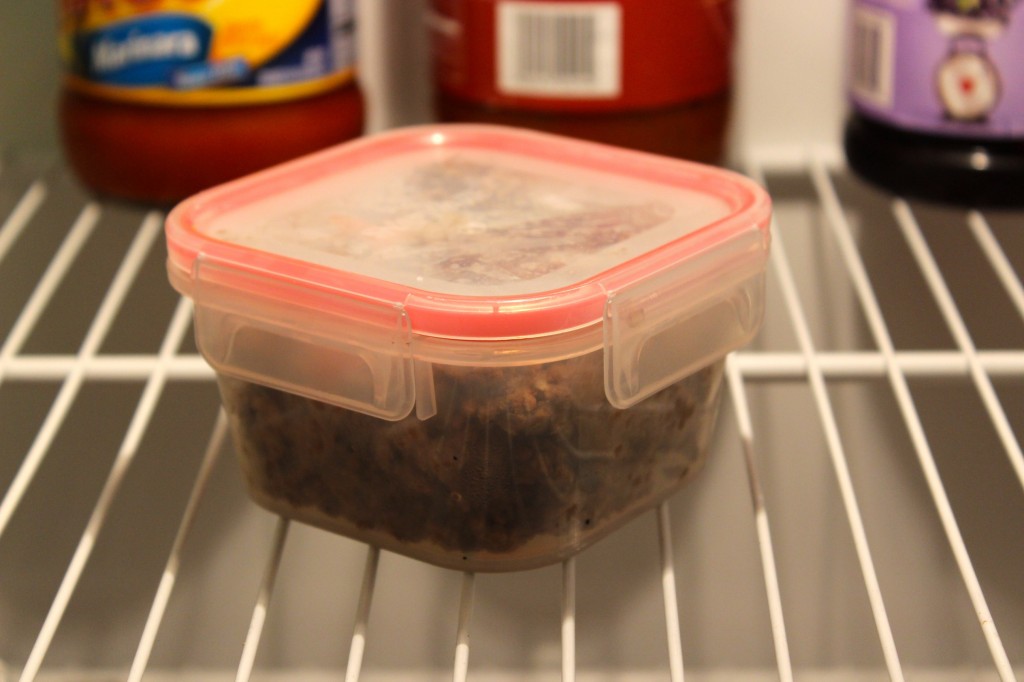Find yourself in front of the fridge, smelling your food, trying to debate if it’s still okay to eat or not? Do you try to convince yourself you’ll probably be fine, but still worry you’ll get sick? A lot of “stomach flu” illnesses are actually cases of preventable food-borne illness, so do your best to avoid tummy woes and get the facts to face your fridge. First and foremost, try to keep food out of the “Temperature Danger Zone” (which is 40°F – 135°F) for no longer than 4 hours total – that includes time you carry the from the grocery store, prep time when cooking, and times you leave your cereal milk out by accident when you’re in class. So set your refrigerator temperature for 40°F or lower, and always cook foods to their minimal internal temperatures.
“High risk foods” are foods high in carbohydrates and protein such as potatoes, pasta, meats, poultry, dairy and rice. Items with a high moisture content are also susceptible — this includes a lot of fruits and vegetables, especially if they are pre-sliced. Be extra careful with these foods. Foods with lots of acid are at lower risk and can usually be kept a little longer. In fact, mayo, often thought to be a huge food safety issue, is actually quite stable compared to a lot of foods due to the high acid content.
And don’t forget the golden rule: when in doubt, throw it out.
Meat:
Meat is one of the most bacteria prone foods in your fridge because bacteria love the high protein and moisture content. So store all of your meat 40°F or lower and follow these guidelines to avoid growing anything funky in your burger:
- ground meat: 3-5 days
- gravy/broths: 1-2 days
- bacon (opened): 1-2 days
- ham – cooked, whole: 7 days
- ham – cooked and sliced: 3-5 days
- luncheon meats (unopened): 2 weeks
- luncheon meats (opened): 1 week
- fresh sausages: 7 days
- smoked sausages: 3-7 days
- dry sausages: 2-3 weeks
- fish: 2-5 days
- shellfish: 2-5 days
- poultry: 1-2 days*
*Poultry is particularly susceptible to Salmonella so be extra careful with storage and avoiding cross-contamination with your chicken and turkey!
Dairy:
Dairy products should also be stored at 40°F or lower and has the following time to sit in your fridge:
- opened milk: 3 days
- butter: 14 days
- soft cheese (opened): 7 days
- hard cheese: up to 6 months
- yogurt (unopened): follow guidelines on packaging
Produce:
Produce is a recommended to be kept at 45°F for leafy vegetables, and 50-70°F for fruits. Delicate fruit like peaches, berries and plums should be stored closer to 50°F, while apples, pears, and citrus fruits can be kept between 50-70°F. Use the following guidelines for best flavor:
- leafy greens: 7 days
- peaches, berries, plums, other stone fruits: 7 days
- apples, pears, and other citrus fruits: 14 days
Leftovers:
Leftovers are tricky. It’s easy to make too much of something, and no one ever really knows how long they’re good for (after all recipes don’t have expiration dates on them)! Follow these guidelines for leftover foods or foods purchased from prepared food bars (like Whole Foods hot bar or pre-made soups), and always store in air-tight containers or plastic bags at 40°F or lower for best results.

Photo by Katherine Baker
- soups and stews: 3-4 days
- cooked meat or poultry: 3-4 days
- pizza: 3-4 days
- pasta: 3-4 days
- rice: 3 days
- salads: 3-5 days
- egg, chicken, ham, tuna & macaroni salads: 3-5 days
In a Cool, Dry Place:
There’s a reason your tomatoes don’t taste as good when you keep them in the fridge: certain foods are actually better off not being kept cold. Some produce, like tomatoes and potatoes, experience chemical changes when exposed to the cold, and then can develop off-flavors. Follow these guidelines for storage, and keep all of following foods between 50-70°F in a dry place with little light exposure:
- root vegetables (ie: potatoes, sweet potatoes, parsnips): 7-30 days
- tomatoes: 3-5 days
- canned goods: 12 months
- squash: varies
Freezer:
If sealed in an airtight container, it’s possible to can extend the life of many of your foods in the freezer. But just because it’s in the freezer, doesn’t mean it’s good forever. Keep your freezer between 0°F and follow these guidelines to ensure freshness and food safety, and avoid freezer burn.
Meat and Seafood:
- ground meat: 1-9 months
- gravy or broth: 3-4 months
- pork – large cuts (like a roast): 6 months
- pork – small cuts (steak or chops): 3 months
- bacon: 1 month
- cooked ham: 1-2 months
- hot dogs: 1 month
- fresh sausages: 3 months
- shellfish: 6-9 months
- most other commercially frozen fish: 2-9 months
- ice cream: up to 3 months
Produce:
- vegetables: 8-12 months
- fruits: 12 months
- salted nuts: 6-8 months
- unsalted nuts: 9-12 months
- herbs: 8-12 months
Reference:
Amy Brown. Understanding Food: Principles and Preparation, 4th Edition. New York, NY: Belmount, CA, Wadsworth, 2010.


